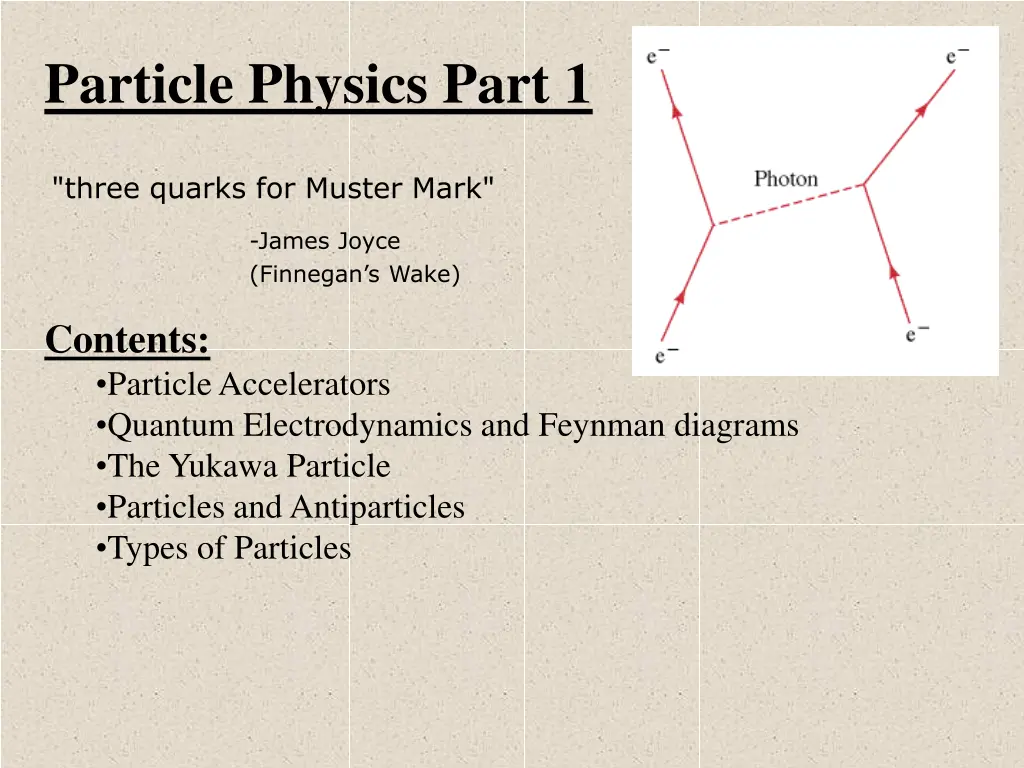
Exploring Particle Physics: Accelerators, Discoveries, and Quantum Electrodynamics
Delve into the fascinating world of particle physics with a comprehensive exploration of particle accelerators, pivotal discoveries in the field, and the intriguing realm of Quantum Electrodynamics. From the fundamental concepts of Vq and E=mc2 to significant breakthroughs like the detection of electrons, positrons, and muons, this journey encompasses the Yukawa Particle, Feynman diagrams, and the mediating role of photons in electromagnetic forces. Discover the mysteries of particles, antiparticles, and the strong nuclear force proposed by Yukawa, offering a compelling insight into the hidden realms of the universe.
Download Presentation

Please find below an Image/Link to download the presentation.
The content on the website is provided AS IS for your information and personal use only. It may not be sold, licensed, or shared on other websites without obtaining consent from the author. If you encounter any issues during the download, it is possible that the publisher has removed the file from their server.
You are allowed to download the files provided on this website for personal or commercial use, subject to the condition that they are used lawfully. All files are the property of their respective owners.
The content on the website is provided AS IS for your information and personal use only. It may not be sold, licensed, or shared on other websites without obtaining consent from the author.
E N D
Presentation Transcript
Particle Physics Part 1 "three quarks for Muster Mark" -James Joyce (Finnegan s Wake) Contents: Particle Accelerators Quantum Electrodynamics and Feynman diagrams The Yukawa Particle Particles and Antiparticles Types of Particles
Particle Accelerators Basic concept - Vq = 1/2mv2 Provide energy for nuclear reactions Create particles from energy (E = mc2) Experiments +150,000 V Proton SourceVacuum Beam Steering (RevereWare)
Particle discoveries: 1877: Electron JJ Thomson and Cathode Rays (they have charge) 1930: Bothe and Becke eject a neutron by bombarding beryllium with alphas 1932: Anderson detects Positron in cosmic ray collisions. (Predicted to exist by Dirac) 1936: Anderson detects the Muon in a cosmic ray collision 1955: Anti protons created with 6 GeV protons: p + p p + p + p + p
SLAC - electron accelerator Potential switches 50 GeV - mass?
Cyclo/Synchro-trons In a magnetic field to curve path/radius Potential switches Mass dilates as v->c Synchrotrons - Fermilab(1.0 km), CERN (8.5 km)
Quantum Electrodynamics Coulomb s law - Force fields Richard Feynman - EM forces are mediated by photons: Richard Feynman 1918-1988 Time Feynman Diagram Virtual photons: large E vs small Charge is the ability to generate virtual photons Exist for so short a time - never detected QED reason for accelerating charges radiating
The Yukawa Particle Photons mediate the EM force Yukawa proposes a particle to mediate strong nuclear force Hideki Yukawa 1907-1981 He names it the meson - (between electron and proton) E t = E(d/c) =h/4 E 130 MeV
The Yukawa Particle Muon discovered in cosmic radiation m = 106 MeV - doesn t interact (not it) The pi meson (pion) is discovered in 1947 in cosmic rays (3 charge states): + - 139.6 MeV/c2 o - 135.0 MeV/c2 - - 139.6 MeV/c2 Hideki Yukawa 1907-1981 p + p --> p + p + o p + p --> p + n + + (conservation of charge)
The Four Forces of Nature Type Strong Nuclear Electromagnetic Weak Nuclear Gravitational Relative Strength 1 10-2 10-6 10-38 Field Particle Gluons (pions) Photon ( ) W+ and Zo Graviton?
Particles and Antiparticles Name Electron Proton Pion Particle e- p + Antiparticle e+ p - Some particles have no antiparticle (They are their own anti particle) + and - are electron charges Two different notations When particle meets antiparticle - annihilation (rest mass + Ek turns to energy or other particles)
Selected list (there are hundreds of hadrons) Self as antiparticle + and - are electron charges . Types of Particles Gauge Bosons - carry the electro-weak force Leptons - interact via weak and EM (charged) force Hadrons - interact via strong nuclear force Mesons (quark/anti quark pairs) Baryons (three quarks)
